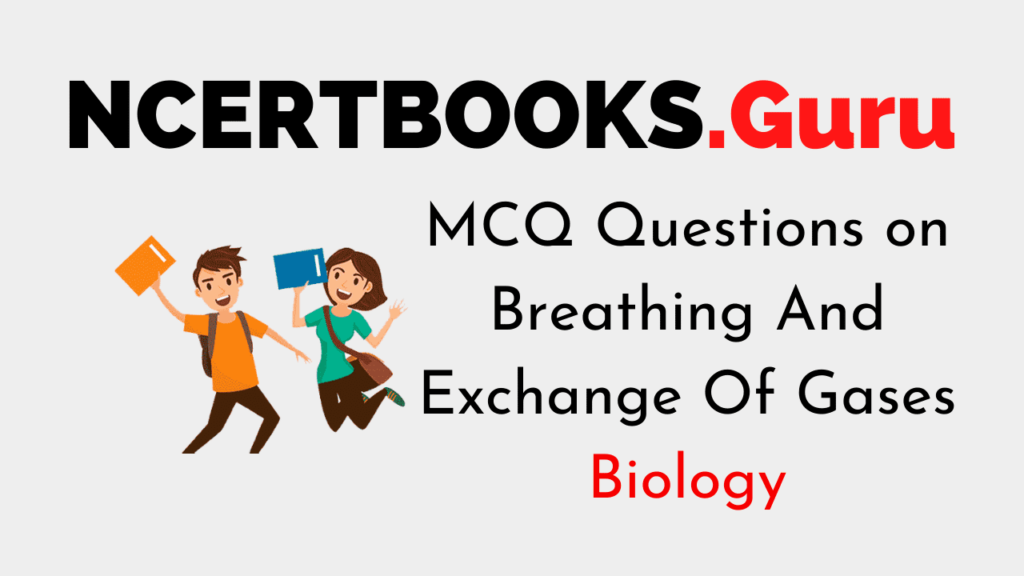MCQ Questions on Breathing And Exchange Of Gases
1. Respiration in mature mammalian erythrocytes are __________
(a) Linear
(b) Absent
(c) Anaerobic
(d) Aerobic
Answer
Answer: (c) Anaerobic
2. __________ is not a characteristic feature of the respiratory surface
(a) Dry
(b) Thin
(c) Permeable
(d) Moist
Answer
Answer: (a) Dry
3. Human skin cannot function as a respiratory organ because
(a) It is not permeable to O2 and CO2
(b) It is rather thick
(c) It is dry
(d) All of the above
Answer
Answer: (d) All of the above
4. In cockroaches, inspiration occurs with __________
(a) Relaxation of tergo-sternal muscles
(b) Relaxation of abdominal muscles
(c) Neither (1) nor (2)
(d) Both (1) and (2)
Answer
Answer: (d) Both (1) and (2)
5. Pick out the statement that is wrong with respect to insects
(a) Abdominal muscles do not take part in respiration
(b) When abdominal muscles relax, the air is drawn in through spiracles and tracheoles
(c) Contracting abdominal muscles drive the air out through the spiracles
(d) Both (2) and (3)
Answer
Answer: (a) Abdominal muscles do not take part in respiration
6. Where does the exchange of gases occur in birds?
(a) Air sacs only
(b) Air sacs and Lungs
(c) Lungs only
(d) First in air sacs and then in the lungs
Answer
Answer: (c) Lungs only
7. Spiracles in cockroaches are analogous to _______ in humans
(a) Trachea
(b) Nostrils
(c) Lungs
(d) None of the above
Answer
Answer: (b) Nostrils
8. Where are the conchae located?
(a) Auricle
(b) Brachioles
(c) Nasal Chambers
(d) Ville
Answer
Answer: (c) Nasal Chambers
9. Laryngeal prominence is also known as __________
(a) Adam’s Apple
(b) Epiglottis
(c) Thyroids
(d) Laryngitis
Answer
Answer: (a) Adam’s Apple
10. Glottis opens on the floor of
(a) Pharyngeal cavity
(b) Diagraphram
(c) Trachea
(d) None of the above
Answer
Answer: (a) Pharyngeal cavity
11. The ring of cartilage that surrounds the trachea is called __________
(a) Treillage
(b) Voicebox
(c) Arytenoid cartilage
(d) Cricoid cartilage
Answer
Answer: (d) Cricoid cartilage
12. __________ prevents the collapse of the trachea
(a) Jugular foramen
(b) Cartilaginous rings
(c) Diaphragm
(d) None of the above
Answer
Answer: (b) Cartilaginous rings
13. __________ is glass-like, translucent cartilage found on many joint surfaces such as nose and trachea.
(a) Elastic cartilage
(b) Fibrous cartilage
(c) Hyaline cartilage
(d) None of the above
Answer
Answer: (c) Hyaline cartilage
14. The number of alveoli in human lungs is estimated to be around __________
(a) 150 million
(b) 500 million
(c) 800 million
(d) 1 billion
Answer
Answer: (b) 500 million
15. The greater fissures in humans are present on
(a) Right lung
(b) Left lung
(c) Both right and left lungs
(d) Not present in the lungs
Answer
Answer: (c) Both right and left lungs
16. Earthworms breathe through their __________
(a) Pores on its anterior end
(b) Head
(c) Skin
(d) Lungs
Answer
Answer: (c) Skin
